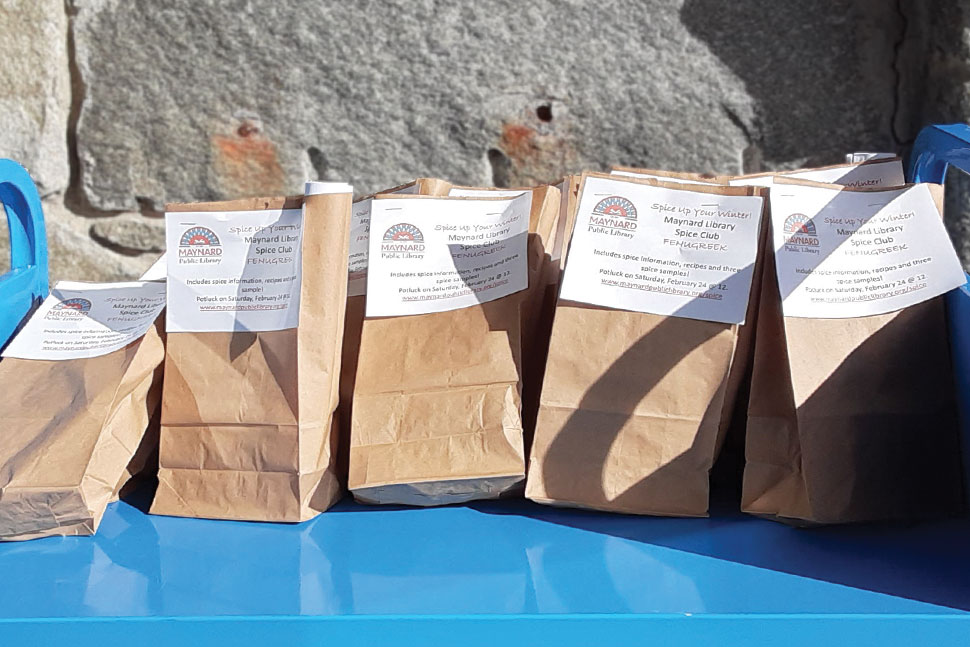
Once a month, the aromas of unique herbs and spices waft through Maynard (Mass.) Public Library (MPL). These spices accent dishes like sweet and spicy tahini noodles, mussakhan (Palestinian roast chicken), and rosemary shortbread, to name a few.
“Staff will come down and say, ‘What’s going on? Everything smells so good,’” says Sally Thurston, MPL’s adult programming coordinator and circulation assistant. Since January 2022, Thurston has run the library’s spice club, which offers patrons kits filled with a featured spice, recipes, and other information based on the selection. Patrons then prepare a dish at home, which they can bring to MPL’s monthly, in-person potluck highlighting the spice.
Spice clubs, which provide seasonings and recipes for patrons, are stirring up a new trend in public libraries. They’re a budget-friendly way for libraries to bring the community together, encourage creativity, and educate patrons about world cuisine, says the librarians who organize them.
Cooking, your way
Spice clubs can be adapted to a variety of formats, with or without in-person components.
Reed Memorial Library (RML) in Ravenna, Ohio, runs a fully at-home spice club, distributing about 25 kits a month. The club has been ongoing since December 2021. Participants have tried recipes such as chicken thighs with roasted carrots using zaatar and Southwest-style turkey soup using chili powder.
The format of RML’s program is flexible enough to reach patrons with varying schedules, says Darlene McKenzie, adult services manager and spice club organizer at RML.
McKenzie says patrons still chat with staffers at the pick-up spot about their experiences in the kitchen. “People are very happy with it,” she says of the program. “They send us pictures. We have regulars who, every month, they come in, and they’re like, ‘There’s my spice!’”
Everett (Wash.) Public Library’s (EPL) spice club program began in October 2022 and ran through February 2023. It was a hybrid program, offering at-home spice kits in tandem with some in-person events.
EPL chose sumac as its first featured spice. The library hosted author and California-based chef Reem Assil to discuss how these tangy dried berries are used in Middle Eastern cuisine and present her cookbook, Arabiyya: Recipes from the Life of an Arab in Diaspora. Assil shared her recipe for fatayer sabanekh (spinach and onion turnovers).
“We’ve heard stories from families that had never tried these spices before,” says Andrea Wallis, EPL librarian and organizer of the spice club. “People would tell us how their recipe turned out, or if they tried the spice for something else.”
Staff will come down and say, ‘What’s going on? Everything smells so good.’
A melting pot of ideas
EPL’s spice club was sponsored by the local Sno-Isle Food Co-op, which provided enough spices to fill approximately 600 kits. Participants were given recipes for chewy gingerbread cookies, beef pho noodle bowls using star anise, and chicken paprikash.
The program coincided with the library’s Everett Reads literacy initiative, which donated 25 free copies of Assil’s cookbook for Sno-Isle to give away to their co-op customers.
“We were able to reach people who weren’t in the library,” Wallis says of the partnership.
MPL’s potluck events took some time to gain popularity, Thurston says, but they ultimately cultivated a core group of at least a dozen patrons who attend monthly. “Everyone mentions what they made, what they liked about it, what they didn’t like about it,” she explains. “Would they have it again? Would their husband eat it? Which is a big thing for some people.”
The opportunity to experiment with spices from all over the world is especially beneficial for the town of Maynard, which doesn’t have a large international population, says Thurston. She adds, “Having something from Morocco or Thailand or Uzbekistan is inherently interesting.”
Sage advice
Hosting a spice club is friendly on a library’s budget, according to organizers.
The spices themselves are the main cost, but they are distributed in sample sizes. Some spices are pricier than others, especially those facing supply shortages, like cardamom.
For patrons, spice clubs are a way to sample different flavors and styles of cooking without investing too much in ingredients they may not end up liking, says Thurston. She aims to include affordable recipes that cover different skill levels, courses, and dietary restrictions so that cooks can start with ease. “You’re jumping over that barrier,” Thurston says, “and someone has chosen some things for you to pick from.”
Having a variety of spices and herbs is important, but libraries should also highlight those that may already be familiar to patrons, so that participants may feel less intimidated, says McKenzie. “You can then move on to including more adventurous spices,” which for some patrons might mean a tandoori spice mix or Japanese curry powder, she adds.
Overall, librarians agree spice clubs help patrons discover a new passion for food that they can share with others.
“There’s no pressure. If you totally fail, everyone’s like, ‘Oh, yeah, that recipe was hard,’” Thurston says. “People can learn. Learn from mistakes, learn from failures. That’s always a good thing.”


